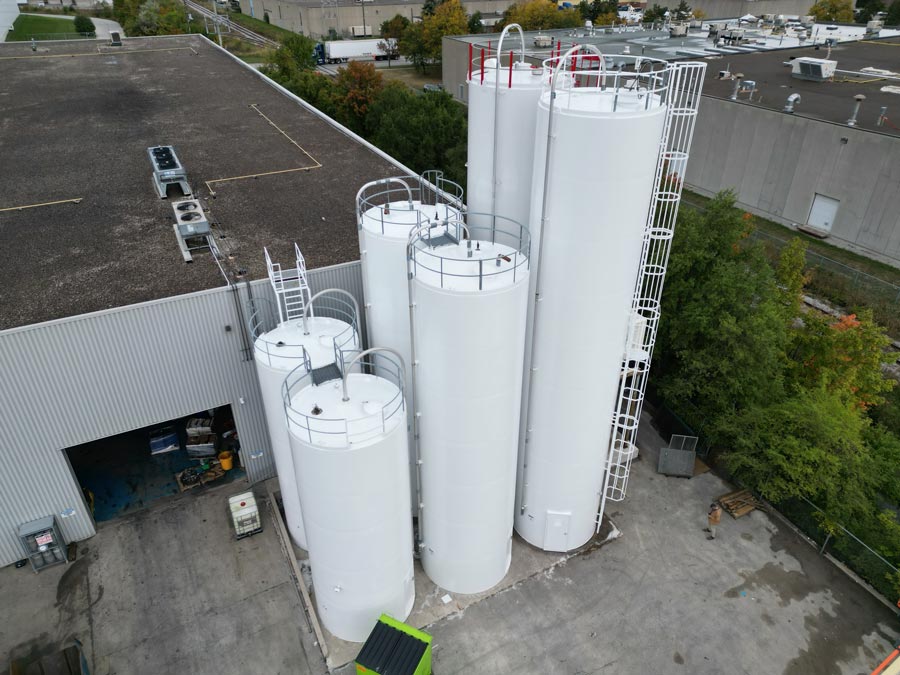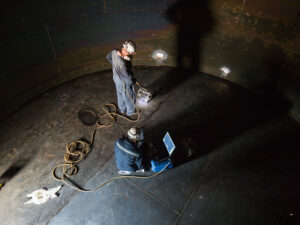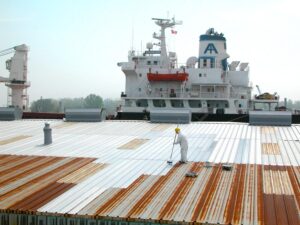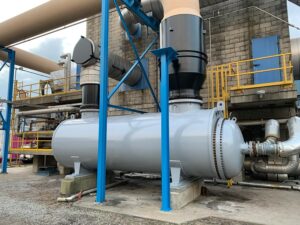Keeping your silos in good shape is key. Industrial silo painting makes your place look better and protects it from damage. Getting expert services for painting means your silos will last longer and work better.
Going for silo painting means saving money in the long run. Good paint can make your silos last longer, avoiding expensive fixes. Choosing the right people for the job means your place will run smoothly.
Key Takeaways
- Industrial silo painting protects against corrosion and environmental factors.
- Expert services enhance the durability of your silos.
- Regular maintenance can be cost-effective in the long run.
- Choosing professionals ensures quality and longevity of coatings.
- Investing in silo painting contributes to the overall efficiency of your facility.
Understanding the Importance of Silo Painting
Industrial silo painting keeps your silos working well. Professional coatings offer more than just looks. They protect against damage and meet industry standards. Your facility’s look will also improve, helping your brand.
Benefits of Professional Silo Coatings
Professional coatings do more than make your silos look good. They offer:
- Protection against corrosion and environmental damage
- Increased resistance to chemicals that may pose a threat
- Improved visual appeal, creating a positive impression on clients
- Adherence to industry regulations and safety standards
Long-Term Impact on Silo Longevity
Investing in silo painting makes them last longer. A good coating stops rust and damage, leading to:
- Prolonged lifespan of silo structures
- Reduction in frequent repairs, saving costs in the long run
- Enhanced operational efficiency through fewer interruptions
- Positive contribution to overall facility productivity
Understanding silo coatings is key to your facility’s success. It ensures sustainability and efficiency for years.
What to Look for in Silo Painting Services
When looking for silo painting services, know what to look for in professional silo painters. Look for qualities that show they’re experts. This helps you find the right service for your needs.
Key Qualities of Professional Silo Painters
Here’s what to look for in professional silo painters:
- Experience: Choose painters with a proven track record in silo projects. Their experience shows they can handle any challenge.
- Certifications: Make sure they have the right certifications and training. This ensures they follow safety standards.
- High-Quality Materials: They should use the best materials. This ensures your silos last longer and are protected.
Evaluating Industrial Painting Companies
When evaluating industrial painting companies, follow these steps:
- Reputation: Check what others say about them. Look for positive reviews and testimonials.
- Portfolio: See their past work. This shows their quality and variety.
- Communication: A good company keeps you updated. They should communicate well throughout the project.
By focusing on these aspects, you can confidently select the right silo painting services that meet your expectations and ensure the protection of your facility.
Industrial Silo Painting: Techniques and Best Practices
Understanding the various techniques and best practices is key for a high-quality finish in industrial silo painting. Skilled painters use different methods to apply the coating evenly and effectively. This ensures the silo is well-protected against corrosion and wear.
Spray painting is a common technique. It provides uniform coverage and can work on various surfaces. Specialized spray equipment helps the paint stick well to the silo, reducing drips and uneven layers. Safety is crucial, with protective gear and proper ventilation for workers and the coating’s integrity.
Surface preparation is another critical best practice. The silo must be cleaned and any loose material removed before painting. This step improves adhesion and extends the coating’s life. Choosing the right paint, based on the silo’s material and environment, is also vital for durability.
The table below highlights some key industrial silo painting techniques along with their benefits:
| Technique | Benefits |
| Spray Painting | Uniform coverage, quick application, and minimal waste |
| Brush Painting | Ideal for small areas and detailed work; allows for control |
| Roller Application | Effective for large surfaces; produces a smooth finish |
| Powder Coating | Highly durable; resistant to chipping, scratching, and fading |
Using the right industrial silo painting techniques and following best practices is crucial for success. Each method has its own benefits. Understanding these can help you make informed decisions. Trusting professional services ensures quality and durability.
Essential Commercial Silo Coatings
Choosing the right commercial silo coatings is vital for protecting your assets. Different environments need different types of coatings for optimal performance and longevity. Knowing these differences helps make informed investment choices.
Types of Coatings for Different Industries
Different sectors use various types of coatings to meet their needs. Here’s a look at some common coatings:
- Acrylic Coatings: Suitable for agricultural silos, offering great protection against UV rays.
- Epoxy Coatings: Ideal for food storage silos due to their resistance to chemicals and moisture.
- Polyurethane Coatings: Commonly used in chemical processing industries as they withstand harsh environments.
- Zinc-Rich Coatings: Ideal for external surfaces requiring rust protection and durability.
Understanding Coating Lifespan and Durability
The coating lifespan varies based on the environment, coating type, and maintenance. Here’s a general overview of durability for common coatings:
| Type of Coating | Typical Lifespan | Durability Features | |
| Acrylic Coatings | 5-7 years | UV resistance, Color retention | |
| Epoxy Coatings | 7-10 years | Chemical resistance, Low maintenance | |
| Polyurethane Coatings | 10-15 years | Excellent flexibility, High resistance to abrasion | |
| Zinc-Rich Coatings | 15-20 years | Corrosion resistance, Strong bonding properties | |
Knowing about types of coatings and their lifespan helps you pick the best industrial coating solutions. This choice should match your long-term goals.
Choosing the Right Industrial Coating Solutions
Choosing the right industrial coating solutions needs careful thought. You must think about the environment, material, and what you need. This careful choice leads to better protection and longer life for your facilities.
Factors to Consider When Selecting Coatings
- Environmental Conditions: Look at temperature, humidity, and chemical exposure. These affect how well coatings work.
- Material Compatibility: Make sure coatings fit your silos or surfaces well. This prevents bad adhesion or early failure.
- Longevity Requirements: Decide how long you need the coating to last. This depends on how you use your facility and maintenance plans.
- Application Method: Think about how easy it is to apply. Some coatings need special techniques or tools for best results.
Customizing Coatings for Specific Applications
Customizing coatings for your needs can improve their performance and life. Tailored solutions should tackle specific challenges. This ensures coatings work well and meet your facility’s needs.
| Coating Type | Application Environment | Customization Features |
| Epoxy Coatings | Chemical Processing Facilities | High chemical resistance and durability |
| Polyurethane Coatings | Outdoor Silos | UV stability and weather resistance |
| Vinyl Coatings | Food Storage | Non-toxic and easy to clean |
| Thermal Spray Coatings | High-Temperature Environments | Customized thermal resistance characteristics |
The Role of Silo Maintenance Services
Silo maintenance services are key to keeping your facility running well. Focus on preventative maintenance to avoid costly repairs. Regular checks help spot problems early, keeping your silos in top shape.
Preventative Maintenance vs. Reactive Solutions
Using preventative maintenance is key to keeping your silos safe from sudden failures. It involves regular care and catching problems early, which can save money and improve performance. On the other hand, waiting for problems to happen can lead to expensive fixes and downtime. Choosing the right maintenance plan can really help.
Scheduling Regular Inspections and Repairs
Regular inspections are vital for your silos’ safety. They should be part of a detailed maintenance plan. Experts can spot wear and damage during these checks. Here’s what makes a good inspection and repair schedule:
- Annual thorough inspections to evaluate structural and coating integrity.
- Bi-annual checks focusing on specific areas prone to damage.
- Immediate assessments following severe weather or unexpected events.
- Timely repairs based on inspection findings to prevent further deterioration.
| Maintenance Type | Description | Frequency |
| Preventative Maintenance | Scheduled care to prevent issues
before they occur |
Ongoing |
| Regular Inspections | Thorough checks of silo condition
and performance |
Annual/Bi-annual |
| Reactive Maintenance | Fixing issues after they arise | As needed |
In conclusion, focusing on silo maintenance services and regular checks will keep your silos running well and last longer.
Signs that Indicate the Need for Silo Restoration Experts
Knowing when to call for silo restoration is crucial for your investment and safety. Spotting signs of damage early can prevent bigger problems. Being aware of wear indicators helps extend your silo’s life.
Key Indicators of Wear and Damage
Several signs suggest you need silo restoration experts. Look out for these:
- Rust: Rust can weaken your silo and should not be ignored.
- Peeling Paint: This can cause moisture buildup and further damage.
- Cracks and Crevices: Visible cracks may indicate weakening and potential failure.
- Leaking Materials: Leaks often signal underlying damage.
When to Call for Professional Help
Knowing when to get help from silo restoration experts can save you money. If you see any of the above wear indicators, get an inspection right away. Also, if maintenance checks show worsening damage, call professionals for a full assessment. Quick action keeps your silo safe and extends its life.
The Process of Quality Silo Painting
Quality silo painting involves several steps for a successful project. It starts with pre-painting preparation, a critical phase. Then, experts use various painting application techniques and tools for consistent, high-quality results.
Pre-Painting Preparation Steps
Before painting, pre-painting preparation is key. This includes:
- Inspecting the silo’s surface for damage and corrosion.
- Cleaning the surface thoroughly to remove dust, dirt, and previous coatings.
- Conducting necessary repairs to ensure a smooth application.
- Applying primers suited to the specific conditions of the silo.
Application Techniques and Equipment Used
With the silo prepped, it’s time for the application phase. Quality silo painting needs good painting application techniques. These include:
- Spray painting for even coverage and efficiency.
- Roller application for thicker coatings on larger surfaces.
- Brush application for detailed work around edges and fittings.
The tools used can vary. But, high-performance sprayers, industrial rollers, and advanced brushes are common. They ensure every layer sticks well and lasts long.
| Preparation Steps | Application Techniques | Equipment |
| Inspecting Surface | Spray Painting | High-Performance Sprayers |
| Cleaning | Roller Application | Industrial Rollers |
| Repairs as Needed | Brush Application | Advanced Brushes |
| Applying Primers | Various Techniques | Personal Protection Equipment |
Meticulous preparation and skilled application are key to top-notch quality silo painting.
Cost Factors in Industrial Silo Painting Projects
Knowing the cost factors in industrial silo painting is crucial for budgeting. Many elements affect the total cost. By understanding these, you can better plan your budget. This section explores these costs and the value of services from professional painters.
Estimating Painting Costs
When estimating painting costs, consider several factors. These include:
- Surface Size: The silo’s area greatly affects material and labor costs.
- Preparation Work: Costs rise with cleaning, priming, or repairs before painting.
- Coating Type: Different paints vary in price, impacting your budget.
- Accessibility: Special equipment for access, like scaffolding, increases labor costs.
- Location: Geographic area affects labor rates and transportation costs.
Understanding Value versus Price
When evaluating the value of services, consider these points:
- Long-Term Durability: Quality materials mean less maintenance costs over time.
- Expertise of Contractors: Experienced pros can prevent costly errors.
- Warranty Offers: Services with warranties show a commitment to quality and protect your investment.
- Client Reviews: Feedback from past customers indicates service quality.
| Cost Factor | Impact on Cost | Value Consideration |
| Surface Size | Higher total area increases material and labor costs. | Investing in quality coverage ensures adequate protection. |
| Preparation Work | Additional costs for cleaning and repairs. | Thorough preparation extends the life of the coating. |
| Coating Type | Varies by product; specialty coatings may cost more. | Better coatings provide greater durability and protection. |
| Accessibility | Unique challenges can raise labor costs. | Using skilled professionals mitigates risks associated with inaccessibility. |
| Location | Regional labor rates influence overall pricing. | Local expertise may enhance service value. |
Finding the Best Industrial Painting Services in Canada
Choosing the best industrial painting services is crucial for your assets’ longevity and look. It’s wise to do thorough research. Knowing what to look for helps you pick a company that fits your needs.
Researching Local Companies and Their Expertise
Start by finding local experts in industrial painting. Look at their past projects and industry experience. Here are tips to help you make a good choice:
- Check their portfolio for projects like yours.
- Ask about their team’s qualifications and certifications.
- See if they use top-quality materials and modern methods.
- Find out about their safety measures and compliance.
| Criteria | Importance | Example Indicators |
| Experience | High | Years in business, portfolio of completed projects |
| Customer Service | Medium | Response time, willingness to address concerns |
| Quality of Work | High | Customer reviews, project photos, warranty offers |
| Competitive Pricing | Medium | Quotes compared to industry standards |
Conclusion
Industrial silo painting is very important. We’ve seen how expert services improve your facility’s durability and performance. A good silo painting job protects against corrosion, looks better, and lasts longer.
Professional silo painting services protect your investment and keep operations running smoothly. By focusing on maintenance and choosing the right coatings, you can make your silos last longer. This means fewer problems and lower costs in the long run.
When thinking about your facility, remember that good silo management is key. It’s about quality work and planning. Whether you need to refresh your silos or prevent problems, investing in industrial silo painting is a smart move.
FAQ
What are the benefits of professional silo painting services?
Professional silo painting services provide crucial protection against corrosive elements, enhance the visual appeal of your facility, and ensure compliance with industry standards. By investing in quality silo painting, you extend the life of your silos and reduce long-term repair costs.
How can I choose the right industrial painting company?
To choose the right industrial painting company, look for key qualities such as experience, certifications, and the usage of high-quality materials. Evaluate their reputation through customer reviews and testimonials to ensure reliability and expertise.
What should I expect from silo maintenance services?
Silo maintenance services focus on preventative measures, scheduling regular inspections and maintenance to catch potential issues early. This proactive approach helps keep your silos in optimal condition, ultimately saving you from costly repairs.
What signs indicate the need for silo restoration?
Key indicators of wear and damage that signal the need for professional silo restoration include rust, peeling paint, and structural weaknesses. It’s essential to call for help from silo restoration experts as soon as these signs appear to prevent further deterioration.
What are the different types of commercial silo coatings?
Commercial silo coatings vary depending on the industry. Solutions can include specialized coatings for agricultural, food storage, and chemical processing sectors, designed to withstand specific environmental conditions, ensuring durability and longevity.
How are industrial silo painting costs estimated?
Estimating industrial silo painting costs involves considering factors such as the size and condition of the silo, the type of coating required, and any necessary repairs prior to painting. Balancing value and price is essential to make informed financial decisions.
What techniques do professional silo painters use?
Professional silo painters use various techniques, including spray painting and specialized application equipment, to ensure an even coat and optimal protection. Understanding these methods reassures you of the quality to expect from industrial painting companies.
What is the lifespan of industrial coatings?
The lifespan of industrial coatings largely depends on the type used and environmental factors. High-quality coatings can last several years, but regular maintenance and inspections play a key role in prolonging their efficacy.
How can I customize coatings for specific applications?
Customizing coatings can be achieved by considering factors like the operational environment, the specific materials involved, and your unique performance needs. We recommend consulting with industrial coating solutions experts to tailor the coatings for optimal results.
What are the best practices for silo painting?
Best practices for silo painting include meticulous pre-painting preparation, using appropriate application techniques, and ensuring the use of advanced equipment. Observing these practices helps guarantee the quality and durability of the finished project.





